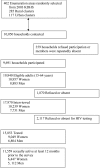Correlates of HIV Infection Among Sexually Active Adults in Kenya: A National Population-Based Survey
- PMID: 22253668
- PMCID: PMC3257551
- DOI: 10.2174/1874613601105010125
Correlates of HIV Infection Among Sexually Active Adults in Kenya: A National Population-Based Survey
Abstract
Objective: To identify factors associated with prevalent HIV in a national HIV survey in Kenya.
Methods: The Kenya AIDS Indicator Survey was a nationally representative population-based sero-survey that examined demographic and behavioral factors and serologic testing for HIV, HSV-2 and syphilis in adults aged 15-64 years. We analyzed questionnaire and blood testing data to identify significant correlates of HIV infection among sexually active adults.
Results: Of 10,957 eligible women and 8,883 men, we interviewed 10,239 (93%) women and 7,731 (87%) men. We collected blood specimens from 9,049 women and 6,804 men of which 6,447 women and 5,112 men were sexually active during the 12 months prior to the survey. HIV prevalence among sexually active adults was 7.4%. Factors independently associated with HIV among women were region (Nyanza vs Nairobi: adjusted OR [AOR] 1.6, 95%CI 1.1-2.3), number of lifetime sex partners (6-9 vs 0-1 partners: AOR 3.0, 95%CI 1.6-5.9), HSV-2 (AOR 6.5, 95%CI 4.9-8.8), marital status (widowed vs never married: AOR 2.7, 95%CI 1.5-4.8) and consistent condom use with last sex partner (AOR 2.3, 95%CI 1.6-3.4). Among men, correlates of HIV infection were 30-to-39-year-old age group (AOR 5.2, 95%CI 2.6-10.5), number of lifetime sex partners (10+ vs 0-1 partners, AOR 3.5, 95%CI 1.4-9.0), HSV-2 (AOR 4.7, 95%CI 3.2-6.8), syphilis (AOR 2.4, 95%CI 1.4-4.0), consistent condom use with last sex partner (AOR 2.1, 95% CI 1.5-3.1) and lack of circumcision (AOR 4.0, 95%CI 2.8 - 5.5).
Conclusion: Kenya's heterogeneous epidemic will require regional and gender-specific prevention approaches.
Keywords: AIDS Indicator Survey; HIV; HIV prevalence; Kenya; Nyanza; Population-based; Sexually transmitted infection..
Figures
Similar articles
-
Identifying Risk Factors for Recent HIV Infection in Kenya Using a Recent Infection Testing Algorithm: Results from a Nationally Representative Population-Based Survey.PLoS One. 2016 May 19;11(5):e0155498. doi: 10.1371/journal.pone.0155498. eCollection 2016. PLoS One. 2016. PMID: 27195800 Free PMC article.
-
Epidemiology of syphilis in Kenya: results from a nationally representative serological survey.Sex Transm Infect. 2011 Oct;87(6):521-5. doi: 10.1136/sextrans-2011-050026. Sex Transm Infect. 2011. PMID: 21917697
-
Factors associated with HIV infection in married or cohabitating couples in Kenya: results from a nationally representative study.PLoS One. 2011 Mar 15;6(3):e17842. doi: 10.1371/journal.pone.0017842. PLoS One. 2011. PMID: 21423615 Free PMC article.
-
Lack of knowledge of HIV status a major barrier to HIV prevention, care and treatment efforts in Kenya: results from a nationally representative study.PLoS One. 2012;7(5):e36797. doi: 10.1371/journal.pone.0036797. Epub 2012 May 4. PLoS One. 2012. PMID: 22574226 Free PMC article.
-
Risk factors for recent HIV infection in Uganda.JAMA. 2008 Aug 6;300(5):540-9. doi: 10.1001/jama.300.5.540. JAMA. 2008. PMID: 18677026
Cited by
-
Strong association between higher-risk sex and HIV prevalence at the regional level: an ecological study of 27 sub-Saharan African countries.F1000Res. 2018 Dec 2;7:1879. doi: 10.12688/f1000research.17108.1. eCollection 2018. F1000Res. 2018. PMID: 30800288 Free PMC article.
-
Mitigating HIV risk associated with widow cleansing and wife inheritance using combined biomedical and structural interventions in western Kenya: a mathematical modeling study.BMC Med. 2025 Feb 12;23(1):88. doi: 10.1186/s12916-025-03906-5. BMC Med. 2025. PMID: 39940027 Free PMC article.
-
Incidence and predictors of first line antiretroviral regimen modification in western Kenya.PLoS One. 2014 Apr 2;9(4):e93106. doi: 10.1371/journal.pone.0093106. eCollection 2014. PLoS One. 2014. PMID: 24695108 Free PMC article. Clinical Trial.
-
HIV prevalence by ethnic group covaries with prevalence of herpes simplex virus-2 and high-risk sex in Uganda: An ecological study.PLoS One. 2018 Apr 4;13(4):e0195431. doi: 10.1371/journal.pone.0195431. eCollection 2018. PLoS One. 2018. PMID: 29617423 Free PMC article.
-
Attention deficit hyperactivity disorder symptom self-report in adults in Kenya and its associated risk factors, an analysis from a household survey in a demographic surveillance site.Glob Ment Health (Camb). 2015 Jul 29;2:e14. doi: 10.1017/gmh.2015.14. eCollection 2015. Glob Ment Health (Camb). 2015. PMID: 28596862 Free PMC article.
References
-
- Musinguzi J, Kirungi W, Opio A, et al. Comparison of HIV Prevalence Estimates From Sentinel Surveillance and a National Population-Based Survey in Uganda, 2004–2005. J Acquir Immune Defic Syndr. 2009;51(1):78–84. - PubMed
-
- Croce F, Fedeli P, Dahoma M, et al. Risk factors for HIV/AIDS in a low HIV prevalence site of sub-Saharan Africa. Trop Med Int Health. 2007;12(9):1011–7. - PubMed
-
- UNAIDS/WHO Working Group on Global HIV/AIDS and STI Surveillance. Guidelines for measuring national HIV prevalence in population-based surveys. 2005.
LinkOut - more resources
Full Text Sources


